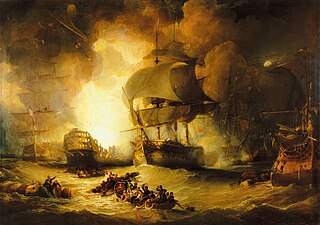
The Battle of the Nile was a major naval battle fought between the British Royal Navy and the Navy of the French Republic at Aboukir Bay on the Mediterranean coast off the Nile Delta of Egypt from the 1st to the 3rd of August 1798. The battle was the climax of a naval campaign that had raged across the Mediterranean during the previous three months, as a large French convoy sailed from Toulon to Alexandria carrying an expeditionary force under General Napoleon Bonaparte. The British fleet was led in the battle by Rear-Admiral Sir Horatio Nelson; they decisively defeated the French under Vice-Admiral François-Paul Brueys d'Aigalliers.

HMS Lion was a 64-gun third-rate ship of the line of the Royal Navy, of the Worcester class, launched on 3 September 1777 at Portsmouth Dockyard.

William Brown was an officer of the British Royal Navy who served in increasingly senior positions during a long period from the American Revolutionary War, including the French Revolutionary War, and until the Napoleonic Wars. He began his naval career as a servant to Captain Philemon Pownoll in the frigate HMS Apollo and became a midshipman after two years. He then served on HMS Resolution with Lord Robert Manners and came home with him in HMS Andromache. He spent the next five years ashore in peacetime. After a brief time on HMS Bounty he was taken off by the First Lord and moved to HMS Ariel before Bounty sailed. He was then moved to HMS Leander, where he was commissioned by Admiral Peyton in 1788. He later captained a series of ships serving in the Mediterranean Sea, the North Sea, the Channel Fleet and then the Mediterranean, again with Lord St Vincent. He captained HMS Ajax in the Blockade of Brest and the Battle of Cape Finisterre and then at Cadiz at Nelson's personal request. After Trafalgar he had a series of shore postings as Dockyard Commissioner at Malta and Shearness before being made Commander in Chief of the Channel Islands and then Jamaica where he died.

The Mediterranean campaign of 1798 was a series of major naval operations surrounding a French expeditionary force sent to Egypt under Napoleon Bonaparte during the French Revolutionary Wars. The French Republic sought to capture Egypt as the first stage in an effort to threaten British India and support Tipu Sultan, and thus force Great Britain to make peace. Departing Toulon in May 1798 with over 40,000 troops and hundreds of ships, Bonaparte's fleet sailed southeastwards across the Mediterranean Sea. They were followed by a small British squadron under Rear-Admiral Sir Horatio Nelson, later reinforced to 13 ships of the line, whose pursuit was hampered by a lack of scouting frigates and reliable information. Bonaparte's first target was the island of Malta, which was under the government of the Knights of St. John and theoretically granted its owner control of the Central Mediterranean. Bonaparte's forces landed on the island and rapidly overwhelmed the defenders, securing the port city of Valletta before continuing to Egypt. When Nelson learned of the French capture of the island, he guessed the French target to be Egypt and sailed for Alexandria, but passed the French during the night of 22 June without discovering them and arrived off Egypt first.

Admiral Sir Manley Dixon, KCB was a prominent Royal Navy officer during the late eighteenth and early nineteenth centuries. Born into a military family in the late 1750s or early 1760s, Dixon joined the Navy and served as a junior officer in the American Revolutionary War, gaining an independent command in the last year of the war. Promoted to captain seven years later, Dixon then served in the French Revolutionary Wars in the Channel Fleet and off Ireland until 1798, when he gained command of the 64-gun HMS Lion with the Mediterranean Fleet. Employed in the blockade of Cartagena, on 15 July 1798 Lion fought four Spanish frigates and successfully captured one, Santa Dorothea. Transferred to the Siege of Malta later the same year, Dixon remained off the island for two years, capturing the French ship of the line Guillaume Tell at the action of 31 March 1800. After the Peace of Amiens, Dixon remained in various active commands but saw no action and later retired, advancing to a Knight Commander of the Order of the Bath and a full admiral.
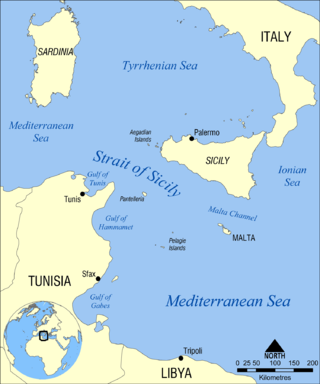
The action of 27 June 1798 was a minor naval engagement between British and French frigates in the Strait of Sicily in the Mediterranean Sea. The engagement formed part of a wider campaign, in which a major French convoy sailed from Toulon to Alexandria at the start of the Napoleonic campaign in Egypt. The French frigate Sensible had been detached from the convoy after the capture of Malta, under orders to carry wounded soldiers and looted treasure back to France while the main body continued to Egypt. The British frigate HMS Seahorse was one of a number of vessels detached from the main British Mediterranean Fleet in the Tagus River, sent to augment the fleet under Sir Horatio Nelson that was actively hunting the French convoy.
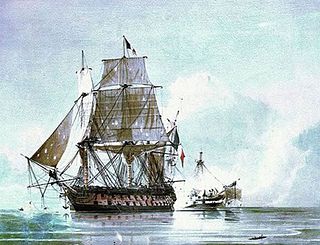
The action of 18 August 1798 was a minor naval engagement of the French Revolutionary Wars, fought between the British fourth rate ship HMS Leander and the French ship of the line Généreux. Both ships had been engaged at the Battle of the Nile three weeks earlier, in which a British fleet under Rear-Admiral Sir Horatio Nelson had destroyed a French fleet at Aboukir Bay on the Mediterranean coast of Egypt. Généreux was one of only four French ships to survive the battle, while Leander had been detached from the British fleet by Nelson on 6 August. On board, Captain Edward Berry sailed as a passenger, charged with carrying despatches to the squadron under Earl St Vincent off Cadiz. On 18 August, while passing the western shore of Crete, Leander was intercepted and attacked by Généreux, which had separated from the rest of the French survivors the day before.

The siege of Malta, also known as the siege of Valletta or the French blockade, was a two-year siege and blockade of the French garrison in Valletta and the Three Cities, the largest settlements and main port on the Mediterranean island of Malta, between 1798 and 1800. Malta had been captured by a French expeditionary force during the Mediterranean campaign of 1798, and garrisoned with 3,000 soldiers under the command of Claude-Henri Belgrand de Vaubois. After the British Royal Navy destroyed the French Mediterranean Fleet at the Battle of the Nile on 1 August 1798, the British were able to initiate a blockade of Malta, assisted by an uprising among the native Maltese population against French rule. After its retreat to Valletta, the French garrison faced severe food shortages, exacerbated by the effectiveness of the British blockade. Although small quantities of supplies arrived in early 1799, there was no further traffic until early 1800, by which time starvation and disease were having a disastrous effect on the health, morale, and combat capability of the French troops.
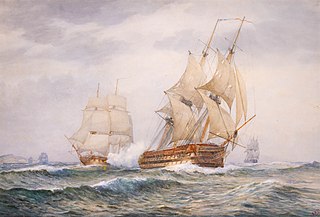
The Battle of the Malta Convoy was a naval engagement of the French Revolutionary Wars fought on 18 February 1800 during the Siege of Malta. The French garrison at the city of Valletta in Malta had been under siege for eighteen months, blockaded on the landward side by a combined force of British, Portuguese. and irregular Maltese forces and from the sea by a Royal Navy squadron under the overall command of Lord Nelson from his base at Palermo on Sicily. In February 1800, the Neapolitan government replaced the Portuguese troops with their own forces and the soldiers were convoyed to Malta by Nelson and Lord Keith, arriving on 17 February. The French garrison was by early 1800 suffering from severe food shortages, and in a desperate effort to retain the garrison's effectiveness a convoy was arranged at Toulon, carrying food, armaments and reinforcements for Valletta under Contre-amiral Jean-Baptiste Perrée. On 17 February, the French convoy approached Malta from the southeast, hoping to pass along the shoreline and evade the British blockade squadron.

The action of 31 March 1800 was a naval engagement of the French Revolutionary Wars fought between a Royal Navy squadron and a French Navy ship of the line off Malta in the Mediterranean Sea. By March 1800 Valletta, the Maltese capital, had been under siege for eighteen months and food supplies were severely depleted, a problem exacerbated by the interception and defeat of a French replenishment convoy in mid-February. In an effort to simultaneously obtain help from France and reduce the number of personnel maintained in the city, the naval commander on the island, Contre-amiral Pierre-Charles Villeneuve, ordered his subordinate Contre-amiral Denis Decrès to put to sea with the large ship of the line Guillaume Tell, which had arrived in the port shortly before the siege began in September 1798. Over 900 men were carried aboard the ship, which was to sail for Toulon under cover of darkness on 30 March.

HMS Santa Dorothea was a Royal Navy 34-gun fifth-rate. This frigate had previously served in the Spanish Navy under the name Santa Dorotea. Built in Spain in 1775, she served during the early years of the French Revolutionary Wars until being captured while sailing as part of a squadron off Cartagena. Taken into British service, she spent the rest of the French Revolutionary and most of the Napoleonic Wars under the white ensign until being broken up in 1814.
The action of 19 December 1796 was a minor naval engagement of the French Revolutionary Wars, fought in the last stages of the Mediterranean campaign between two British Royal Navy frigates and two Spanish Navy frigates off the coast of Murcia. The British squadron was the last remaining British naval force in the Mediterranean, sent to transport the British garrison of Elba to safety under the command of Commodore Horatio Nelson. The Spanish under Commodore Don Jacobo Stuart were the vanguard of a much larger squadron. One Spanish frigate was captured and another damaged before Spanish reinforcements drove the British off and recaptured the lost ship.
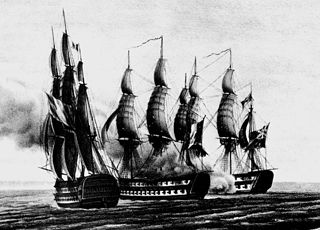
Ganteaume's expeditions of 1801 were three connected major French Navy operations of the spring of 1801 during the French Revolutionary Wars. A French naval squadron from Brest under Contre-amiral Honoré Ganteaume, seeking to reinforce the besieged French garrison in Ottoman Egypt, made three separate but futile efforts to reach the Eastern Mediterranean. The French army in Egypt had been trapped there shortly after the start of the Napoleonic campaign in Egypt in 1798, when the French Mediterranean Fleet was destroyed at the Battle of the Nile. Since that defeat, the French Navy had maintained only a minimal presence in the Mediterranean Sea, while the more numerous British and their allies had succeeded in blockading and defeating several French bases almost unopposed.

The action of 13 October 1796 was a minor naval engagement of the French Revolutionary Wars, fought off the Mediterranean coast of Spain near Cartagena between the British Royal Navy 32-gun frigate HMS Terpsichore under Captain Richard Bowen and the Spanish Navy 34-gun frigate Mahonesa under Captain Tomás de Ayalde. The action was the first battle of the Anglo-Spanish War, coming just eight days after the Spanish declaration of war. In a battle lasting an hour and forty minutes, Mahonesa was captured.

The action of 7 April 1800 was a minor naval engagement fought between a British squadron blockading the Spanish naval base of Cádiz and a convoy of 13 Spanish merchant vessels escorted by three frigates, bound for the Spanish colonies in the Americas. The blockade squadron consisted of the ships of the line HMS Leviathan and HMS Swiftsure and the frigate HMS Emerald, commanded by Rear-Admiral John Thomas Duckworth on Leviathan. The Spanish convoy sailed from Cádiz on 3 April 1800 and encountered Duckworth's squadron two days later. The Spanish attempted to escape; Emerald succeeded in capturing one ship early on 6 April. The British captured a brig the following morning and the British squadron divided in pursuit of the remainder.

The Croisière de Bruix was a naval campaign of the French Revolutionary Wars. Planned and commanded by French Vice-Admiral Étienne Eustache Bruix, the operation was an attempt to restore French control of the Mediterranean Sea, lost at the Battle of the Nile in August 1798. Taking command of the French Atlantic Fleet based at Brest, Bruix mustered one of the largest and best trained French fleets to take to sea during the war. Brest was under close blockade by the British Channel Fleet, but Bruix arranged for misleading intelligence regarding an impending invasion of Ireland to fall into British hands, which drew the blockade fleet under Lord Bridport away to the north. On 25 April 1799 the French fleet of 25 ships of the line sailed into the Atlantic unopposed, sighted the following day by the frigate HMS Nymphe. Reports reached Bridport soon afterwards, but he remained on station off Ireland, anticipating a French attack.
The Croisière de Bruix was the principal naval campaign of the year 1799 during the French Revolutionary Wars. The expedition began in April 1799 when the bulk of the French Atlantic Fleet under Vice-Admiral Étienne Eustache Bruix departed the base at Brest, evading the British Channel Fleet which was blockading the port and tricking the commander Admiral Lord Bridport into believing their true destination was Ireland. Passing southwards, the French fleet narrowly missed joining with an allied Spanish Navy squadron at Ferrol and was prevented by an easterly gale from uniting with the main Spanish fleet at Cádiz before entering the Mediterranean Sea. The Mediterranean was under British control following the destruction of the French Mediterranean Fleet at the Battle of the Nile in August 1798, and a British fleet nominally under Admiral Earl St Vincent was stationed there. Due however to St. Vincent's ill-health, operational control rested with Vice-Admiral Lord Keith. As Keith sought to chase down the French, the Spanish fleet followed Bruix into the Mediterranean before being badly damaged in a gale and sheltering in Cartagena.

Nossa Senhora da Conceição was launched at Lisbon on 13 July 1771 for the Portuguese Navy as a first rate ship of the line of 90 guns. In 1793 she was the flagship of the squadron that the Portuguese Navy provided to assist the British Royal Navy's Channel Fleet. The next year the Portuguese government refitted her and changed her name to Príncipe Real. In 1798-1800 Príncipe Real served in the Mediterranean as the flagship of the Portuguese squadron assisting Admiral Nelson.

The Mediterranean campaign of 1793–1796 was a major theater of conflict in the early years of the French Revolutionary Wars. Fought during the War of the First Coalition, the campaign was primarily contested in the Western Mediterranean between the French Navy's Mediterranean Fleet, based at Toulon in Southern France, and the British Royal Navy's Mediterranean Fleet, supported by the Spanish Navy and the smaller navies of several Italian states. Major fighting was concentrated in the Ligurian Sea, and focused on British maintenance of and French resistance to a British close blockade of the French Mediterranean coast. Additional conflict spread along Mediterranean trade routes, contested by individual warships and small squadrons.

The action of 22 October 1793 was a minor naval engagement fought in the Mediterranean Sea during the War of the First Coalition, early in the French Revolutionary Wars. During the engagement a lone British Royal Navy ship of the line, the 64-gun HMS Agamemnon, attacked the French Navy large frigate Melpomène, part of a larger squadron, off the coast of Sardinia. Although Agamemnon chased Melpomène some distance through the night and inflicted significant damage, the French frigate was able to escape following the arrival of the rest of its squadron under Commodore Jean-Baptiste Perrée. The French ships later anchored in Corsican harbours to land reinforcements for the French garrison on the island, where the population was in open revolt.


















